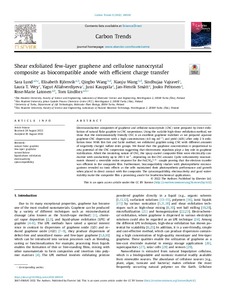Shear exfoliated few-layer graphene and cellulose nanocrystal composite as biocompatible anode with efficient charge transfer
Lindfors Tom; Björnvik Elisabeth; Wey Laura T.; Allahverdiyeva Yagut; Wang Qingbo; Lund Sara; Latonen Rose-Marie; Smått Jan-Henrik; Wang Xiaoju; Kauppila Jussi; Vajravel Sindhujaa; Peltonen Jouko
https://urn.fi/URN:NBN:fi-fe2022102462953
Tiivistelmä
Electroconductive composites of graphene and cellulose nanocrystals (CNC) were prepared by direct exfoliation of natural flake graphite in CNC suspensions. Using the scalable high-shear exfoliation method, we show that the environmentally friendly CNC is an excellent graphene stabilizer as we prepared aqueous graphene-CNC dispersions with a high concentration (4.0 mg ml−1) and yield (4.0%) after only 2 h exfoliation time. With this fast and facile method, we exfoliated graphite using CNC with different amounts of negatively charged sulfate ester groups. We found that the graphene concentration is proportional to zeta potential of the CNC suspension suggesting that electrostatic repulsion plays a key role in graphene stabilization. Albeit the insulating nature of CNC, the spray-coated composite films were electrically conductive with conductivity up to 280 S m−1, depending on the CNC amount. Cyclic voltammetry measurements showed a reversible redox response for the Fe(CN)63-/4− couple proving that the electron transfer was efficient in the composite film. Furthermore, biocompatibility studies with photosynthetic microorganisms revealed no toxic effects as the cells maintained their photosynthetic performance and growth when placed in direct contact with the composite. The cytocompatibility, electroactivity and good water-stability make the composite film a promising anode for bioelectrochemical applications.
Kokoelmat
- Rinnakkaistallenteet [19249]
